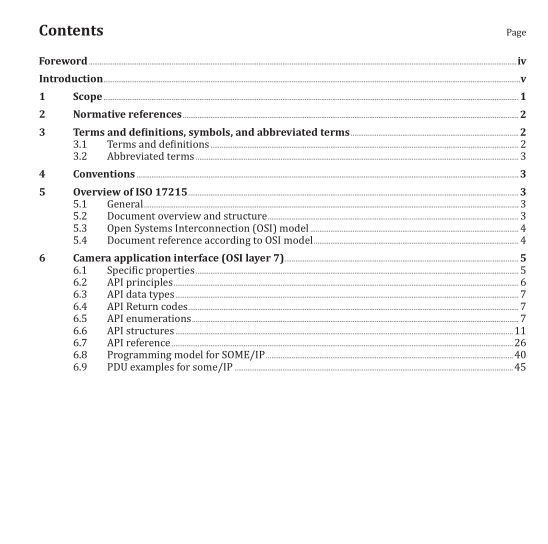ISO 17215-3:2014 pdf download.Road vehicles — Video communication interface for cameras (VCIC) — Part 3: Camera message dictionary
4 Conventions
This International Standard is based on the conventions specified in the OSI service conventions (ISO/IEC°10731) as they apply for physical layer, protocol, network, and transport protocol and diagnostic services.
5 Overview of ISO 17215
5.1 General
This International Standard has been established in order to implement a standardized video communication interface for cameras on a communication data link.
The focus of this International Standard is using existing protocols.
— Figure 1 specifies the relation to the other parts of this International Standard.
— Figure 2 specifies the relation of this International Standard to existing protocols.
5.2 Document overview and structure
This International Standard consists of a set of four sub-documents, which provide all references and requirements to support the implementation of a standardized video communication interface for cameras according to the standard at hand.
— ISO 17215-1 provides an overview of the document set and structure along with use case definitions and a common set of resources (definitions, references) for use by all subsequent parts.
— ISO 17215-2 specifies the discovery and control of services provided by a VCIC camera. — ISO 17215-3 specifies the standardized camera messages and data types used by a VCIC camera (OSI Layer 7). — ISO 17215-4 specifies standardized low-level communication requirements for implementation of the physical layer, data link layer, network layer, and transport layer (OSI Layers 1 to 4). 5.3 Open Systems Interconnection (OSI) model This International Standard is based on the Open Systems Interconnection (OSI) basic reference model as specified in ISO/IEC 7498 which structures communication systems into seven layers. All parts of this International Standard are guided by the OSI service conventions as specified in ISO/IEC 10731 to the extent that they are applicable to diagnostic services. These conventions define the interaction between the service user and the service provider through service primitives. The aim of this subclause is to give an overview of the OSI model and show how it has been used as a guideline for this part of ISO 17215.
It also shows how the OSI service conventions have been applied to this International Standard. The OSI model structures data communication into seven layers called (from top to bottom) the application layer (layer 7), presentation layer, session layer, transport layer, network layer, data link layer, and physical layer (layer 1). A subset of these layers is used in this International Standard. The purpose of each layer is to provide services to the layer above. The active parts of each layer, implemented in software, hardware, or any combination of software and hardware, are called entities. In the OSI model, communication takes place between entities of the same layer in different nodes. Such communicating entities of the same layer are called peer entities. The services provided by one layer are available at the Service Access Point (SAP) of that layer. The layer above can use them by exchanging data parameters This International Standard distinguishes between the services provided by a layer to the layer above it and the protocol used by the layer to send a message between the peer entities of that layer. The reason for this distinction is to make the services, especially the application layer services and the transport layer services, reusable also for other types of networks than the video communication interface for cameras. In this way, the protocol is hidden from the service user and it is possible to change the protocol if demanded by special system requirements.
5.4 Document reference according to OSI model Figure 2 illustrates the document references.
6 Camera application interface (OSI layer 7) 6.1? Specific? properties In the automotive environment, the network topologies are semi-static and the characteristics of all components, including cameras, are bound to a specific car platform design. Components and characteristics of components not included in the design need not to be supported. There is no requirement for a least common video mode. The minimum compatibility requirement is to recognize the reason of unexpected behaviour. Compatibility is ensured during the design phase. Incompatibility will be detected during development, assembling, or repair of a car.ISO 17215-3 pdf download.ISO 17215-3-2014 pdf download
